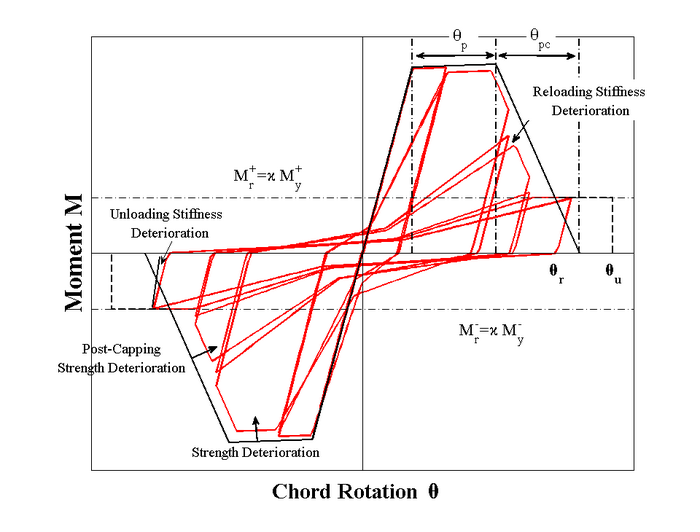Modified Ibarra-Medina-Krawinkler Deterioration Model with Pinched Hysteretic Response (ModIMKPinching Material): Difference between revisions
No edit summary |
No edit summary |
||
| Line 4: | Line 4: | ||
{| | {| | ||
| style="background:yellow; color:black; width:800px" | '''uniaxialMaterial ModIMKPinching $matTag $K0 $as_Plus $as_Neg $My_Plus $My_Neg $FprPos $FprNeg $A_pinch $Lamda_S $ | | style="background:yellow; color:black; width:800px" | '''uniaxialMaterial ModIMKPinching $matTag $K0 $as_Plus $as_Neg $My_Plus $My_Neg $FprPos $FprNeg $A_pinch $Lamda_S $Lamda_C $Lamda_A $Lamda_K $c_S $c_C $c_A $c_K $theta_p_Plus $theta_p_Neg $theta_pc_Plus $theta_pc_Neg $Res_Pos $Res_Neg $theta_u_Plus $theta_u_Neg $D_Plus $D_Neg''' | ||
|} | |} | ||
Revision as of 16:53, 10 September 2012
- Command_Manual
- Tcl Commands
- Modeling_Commands
- model
- uniaxialMaterial
- ndMaterial
- frictionModel
- section
- geometricTransf
- element
- node
- sp commands
- mp commands
- timeSeries
- pattern
- mass
- block commands
- region
- rayleigh
- Analysis Commands
- Output Commands
- Misc Commands
- DataBase Commands
This command is used to construct a ModIMKPinching material. This material simulates the modified Ibarra-Medina-Krawinkler deterioration model with pinching hysteretic response. NOTE: before you use this material make sure that you have downloaded the latest OpenSees version. A youtube video presents a summary of this model including the way to be used within openSees (http://youtu.be/YHBHQ-xuybE).
| uniaxialMaterial ModIMKPinching $matTag $K0 $as_Plus $as_Neg $My_Plus $My_Neg $FprPos $FprNeg $A_pinch $Lamda_S $Lamda_C $Lamda_A $Lamda_K $c_S $c_C $c_A $c_K $theta_p_Plus $theta_p_Neg $theta_pc_Plus $theta_pc_Neg $Res_Pos $Res_Neg $theta_u_Plus $theta_u_Neg $D_Plus $D_Neg |
| $matTag | integer tag identifying material |
| $K0 | elastic stiffness |
| $as_Plus | strain hardening ratio for positive loading direction |
| $as_Neg | strain hardening ratio for negative loading direction |
| $My_Plus | effective yield strength for positive loading direction |
| $My_Neg | effective yield strength for negative loading direction (Must be defined as a negative value) |
| $FprPos | Ratio of the force at which reloading begins to force corresponding to the maximum historic deformation demand (positive loading direction) |
| $FprNeg | Ratio of the force at which reloading begins to force corresponding to the absolute maximum historic deformation demand (negative loading direction) |
| $A_Pinch | Ratio of reloading stiffness |
| $Lamda_S | Cyclic deterioration parameter for strength deterioration [see definitions in Lignos and Krawinkler (2011)] |
| $Lamda_C | Cyclic deterioration parameter for post-capping strength deterioration [see definitions in Lignos and Krawinkler (2011)] |
| $Lamda_A | Cyclic deterioration parameter for acceleration reloading stiffness deterioration [see definitions in Lignos and Krawinkler (2011)] |
| $Lamda_K | Cyclic deterioration parameter for unloading stiffness deterioration [see definitions in Lignos and Krawinkler (2011)] |
| $c_S | rate of strength deterioration. The default value is 1.0. |
| $c_C | rate of post-capping strength deterioration. The default value is 1.0. |
| $c_A | rate of accelerated reloading deterioration. The default value is 1.0. |
| $c_K | rate of unloading stiffness deterioration. The default value is 1.0. |
| $theta_p_Plus | pre-capping rotation for positive loading direction (often noted as plastic rotation capacity) |
| $theta_p_Neg | pre-capping rotation for negative loading direction (often noted as plastic rotation capacity) (must be defined as a positive value) |
| $theta_pc_Plus | post-capping rotation for positive loading direction |
| $theta_pc_Neg | post-capping rotation for negative loading direction (must be defined as a positive value) |
| $Res_Pos | residual strength ratio for positive loading direction |
| $Res_Neg | residual strength ratio for negative loading direction (must be defined as a positive value) |
| $theta_u_Plus | ultimate rotation capacity for positive loading direction |
| $theta_u_Neg | ultimate rotation capacity for negative loading direction (must be defined as a positive value) |
| $D_Plus | rate of cyclic deterioration in the positive loading direction (this parameter is used to create assymetric hysteretic behavior for the case of a composite beam). For symmetric hysteretic response use 1.0. |
| $D_Neg | rate of cyclic deterioration in the negative loading direction (this parameter is used to create assymetric hysteretic behavior for the case of a composite beam). For symmetric hysteretic response use 1.0. |
Image from: Lignos and Krawinkler (2012)
The deterioration model parameters can be calibrated based on actual experimental data of RC beams in terms of load - displacement or moment - rotation. Examples of such calibrations can be found in Lignos (2008) and Lignos and Krawinkler (2012).
References:
| [1] | Lignos, D.G., Krawinkler, H. (2012). “Development and Utilization of Structural Component Databases for Performance-Based Earthquake Engineering", Journal of Structural Engineering, ASCE (accepted for publication). |
| [2] | Lignos, D.G., and Krawinkler, H. (2011). “Deterioration modeling of steel components in support of collapse prediction of steel moment frames under earthquake loading”, Journal of Structural Engineering, ASCE, Vol. 137 (11), 1291-1302. |
| [3] | Lignos, D.G. and Krawinkler, H. (2012). “Sidesway collapse of deteriorating structural systems under seismic excitations,” Rep.No.TB 177, The John A. Blume Earthquake Engineering Research Center, Stanford University, Stanford, CA. [electronic version: https://blume.stanford.edu/tech_reports] |
| [4] | Lignos, D.G. (2008). “Sidesway collapse of deteriorating structural systems under seismic excitations,” Ph.D. Dissertation, Department of Civil and Environmental Engineering, Stanford University, Stanford, CA. |
| [5] | Ibarra L.F., and Krawinkler, H. (2005). “Global collapse of frame structures under seismic excitations”, Rep. No. TB 152, The John A. Blume Earthquake Engineering Center, Stanford University, Stanford, CA. [electronic version: https://blume.stanford.edu/tech_reports] |
| [6] | Ibarra L.F., Medina R. A., and Krawinkler H. (2005). “Hysteretic models that incorporate strength and stiffness deterioration”, Earthquake Engineering and Structural Dynamics, 34(12), 1489-1511. |
Code Developed by : by Dr. Dimitrios G. Lignos, McGill University
